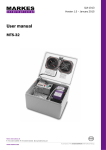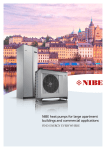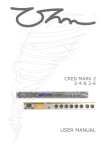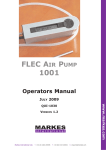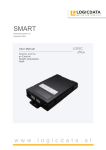Download MTS-32
Transcript
MTS-32 Multiple tube sampler Operator Manual Version 1.3 March 2013 Markes International Ltd. T: +44 (0)1443 230935 F: +44 (0)1443 231531 E: [email protected] www.markes.com QUI-1013 Contents 1 Introduction ........................................................................................................................................................... 3 2 Principles of operation ......................................................................................................................................... 3 3 4 2.1 Principles of MTS-32 ventilation .............................................................................................................. 3 2.2 Principles of sorbent tube sample collection using the MTS-32 ........................................................... 4 Connecting the MTS-32 to a power supply ........................................................................................................ 5 3.1 General battery requirements.................................................................................................................. 5 3.2 Selecting the power option ...................................................................................................................... 6 3.3 Powering the optional internal heaters ................................................................................................... 6 Connecting the sampling pump .......................................................................................................................... 7 4.1 Connecting the ACTI-VOC ......................................................................................................................... 7 4.2 Connecting the FLEC pump...................................................................................................................... 7 5 Setting the timer ................................................................................................................................................... 8 6 Sample tube insertion .......................................................................................................................................... 8 7 Operation ............................................................................................................................................................... 9 8 7.1 Turning on the power ............................................................................................................................... 9 7.2 Summary of operation .............................................................................................................................. 9 7.3 Turning on the pump to begin the sampling sequence........................................................................ 10 7.4 Finishing sampling sequence ................................................................................................................ 10 Battery charging ................................................................................................................................................. 11 8.1 9 Charger circuit for alternative constant-flow sample pumps ............................................................... 11 User maintenance .............................................................................................................................................. 12 www.markes.com 2 1 Introduction There are many monitoring situations where it is necessary to obtain site data over periods of 24 hours or even longer. Continuous on-site monitoring requires a complete analytical system at each monitoring location. However, using an automated collection system based on thermal desorption tubes allows samples to be collected sequentially onto a series of sorbent tubes with no dead or lost time. Each tube can be used to sample the air for periods of minutes to hours. The MTS-32 allows sequential sampling onto a series of up to 32 industry-standard sized sorbent tubes. It is a self-contained unit powered either using an integrated rechargeable 12 V battery or normal 120 V/230 V supply using an appropriate 12 V adaptor. Caution: Although the MTS-32 is contained within a shower-proof box, it should be protected from extreme weather conditions if outdoor sampling is to be carried out. The unit should preferably be located above ground level. 2 Principles of operation 2.1 Principles of MTS-32 ventilation The sampling system is housed in a tough low-emitting polymer box with a polycarbonate sealed lid. Air is drawn over the sampling end of the sorbent tubes by means of a fan and air intake duct. The air inlet and outlet ports are fitted with a fine wire gauze to keep out insects. The same housing incorporates the 12 V supply socket for use, if the MTS-32 is to be battery-powered. The fan is a 12 V, low-speed long-life unit using minimal current from the battery. At 12 V the fan throughput is about 1 L per second, which is enough to change the air over the sampling ends of the sorbent tubes more than 10 times per minute. The general arrangement is shown in Figure 1. 3 www.markes.com Figure 1: Cross-section of MTS-32, indicating air flow. 2.2 Principles of sorbent tube sample collection using the MTS-32 Figure 2 shows a section through the manifold block, which holds up to 32 tubes. The rotating pump connector plate is driven round the base of the manifold block in a clockwise direction until it is positioned in line with the tube to be sampled. Air is then drawn through that tube for the selected time period, before the rotating pump connector plate moves on to the next tube position. The diffusive limiters on the sampling end of each of the tubes tube play a critical role both before and after the sample collection period. Figure 2: Sample flow schematic. 4 www.markes.com Any sorbent tubes not being pumped could potentially take up analytes by diffusion, or lose retained analytes by outgassing. To prevent this, sorbent tubes are protected using either DiffLok™ caps (Figure 3) or SafeLok™ tubes with integrated diffusion-locking inserts at each end (Figure 4). Diffusion-locking inserts are also fitted into every tube connector position in the tube manifold block (Figure 2). Diffusion-locking technology prevents both diffusive ingress of contaminants and loss of retained sample in every tube that is idle in the manifold block, both before and after sampling. Figure 3: Illustration of a DiffLok cap, showing the diffusion-locking insert. Figure 4: Schematic of a SafeLok tube, illustrating the diffusion-locking inserts. 3 Connecting the MTS-32 to a power supply The MTS-32 can be powered either by an integrated 12 V battery (e.g. MTS-5009) or by 120 V/230 V electricity using a 12 V adaptor (MTS-5011). This power drives both the sampling pump and the rotating pump connector plate. 3.1 General battery requirements The mean current for operating the unit is less than 0.1 A, with a similar current required to drive the pump charger. With a total load of 0.2 A, the 10 A h battery available from Markes International will drive the unit (both MTS-32 and ACTI-VOC pump) for 40 hours or more. This battery is fitted with standard, low-voltage connectors, which ensure connection with the correct polarity. Since the battery is sealed, it MUST be charged from a highquality constant-voltage charger. A suitable charger is available from Markes International (MTS-5010). Because this charger is, in effect, a voltage-controlled power unit, it can also be used directly to drive the MTS-32 from mains electricity for indoor or test purposes. The charger is NOT suitable for outside use. If desired, a higher capacity 12 V car battery can be used, for which a simple connecting lead is available (MTS-5013). This would enable the MTS-32 to run for longer than 40 hours. The MTS-32 is protected against reverse polarity connection by a diode inside the unit. 5 www.markes.com The MTS-32 can be run from any 12 V lead–acid battery of sufficient capacity. 3.2 Selecting the power option 3.2.1 Connecting the MTS-32 to a 120 V/230 V electricity supply If the MTS-32 is to be connected to a 120 V/230 V power supply, the mains adaptor (MTS-5011) must be connected to the right-hand-side military-grade socket on the lid of the box (Figure 5). This connection is directly above the fan and air outlet. Figure 5: Plan view of MTS-32 (lid of box). Ensure that the male jack-plug connector leading from the fan outlet is connected to the left-hand “external power in” socket on the MTS-32 control panel (see Figure 9). Do not confuse this with the narrow, solid jack-plug that powers the fan. 3.2.2 Powering the MTS-32 using the integrated 12 V battery option If the MTS-32 is to be used with the integrated battery option (MTS-5009), ensure that the male jack-plug from the battery is connected to the right-hand socket labelled “Battery Power in” on the MTS-32 control panel. 3.2.3 Connecting the MTS-32 to an external 12 V battery If the MTS-32 is to be connected to an external 12 V battery, the external battery adaptor lead (MTS-5013) must be connected to the right-hand-side military-grade socket on the lid of the box (Figure 5). This connection is directly above the fan and air outlet. Ensure that the male jack-plug connector leading from the fan outlet is connected to the left-hand “external power in” socket on the MTS-32 control panel (see Figure 9). Do not confuse this with the narrow, solid jack-plug that powers the fan. Powering the optional internal heaters To prevent internal condensation under foggy or 100% humidity conditions, a heater is suspended from the underside of the air inlet, and another is bolted to the main chassis. If required, these must be run from an independent 12 V power supply, connected to the left-hand military-grade socket on top of the MTS-32 lid (see Figure 5). The heater supplies 12 W, which will raise the temperature of the inlet air by about 10°C. This also enables the unit to run at ambient temperatures below –5°C. Note: Power for these heaters is supplied via a separate pair of shrouded sockets on the unit top, over the tubes. As this heater takes 1 A from the 12 V battery, it has been kept completely separate from the rest of the MTS-32 circuitry, and will require a separate power supply. A car battery of more than 25 A h capacity will drive the heaters for 24 hours. To connect the external battery to the MTS-32, an external battery adaptor lead is required (MTS-5013). 6 www.markes.com 3.3 4 Connecting the sampling pump The MTS-32 is designed to operate with an ACTI-VOC (C-LFP-01) or FLEC air sampling pump. These are constant-flow pumps that will deliver the same flow through tubes of different impedance. Constant-flow pumps from other manufacturers may be used, and a general-purpose pump socket is provided (Figure 6). However, Markes International should be consulted for advice regarding power and connection details, before you connect the pump. Figure 6: Plan view of MTS-32 (inside box). 4.1 Connecting the ACTI-VOC Connect the power inlet of the ACTI-VOC to the connection shown (Figure 6), using the cable (MTS-5019). Note: When then the MTS-32 is switched on, the level of current being supplied to the pump is shown on the gauge. The variable resistor should be adjusted to show no more than 100 mA. This can be done by turning the dial (Figure 7) anti-clockwise. Connect the ACTI-VOC pump air inlet to the ⅛″ copper tubing shown in Figure 2. Place the pump on the righthand-side of the box, on top of the integrated battery (if present). Note: The back-pressure adaptor supplied with the ACTI-VOC should not be used with the MTS-32. 4.2 Connecting the FLEC pump Connect the power inlet of the FLEC pump to the connection shown (see Figure 6). 7 www.markes.com Figure 7: Variable resistor dial. Note: When then the MTS-32 is switched on, the level of current being supplied to the pump is shown on the gauge. The variable resistor is only adjusted if the MTS-32 is being used with an ACTI-VOC or alternative pump. Connect the FLEC pump air inlet to the ⅛″ copper tubing shown in Figure 2. Place the pump on the right-handside of the box, on top of the integrated battery (if present). 5 Setting the timer As shown in Figure 8, the left-hand alphanumeric display denotes the mode of operation of the timer. This should always be set to “B”. The far-right-hand alphanumeric display denotes the unit of time (ranging from 0.1 s to 10 h). Figure 8: Timer display. The middle three alphanumeric displays denote the number of time units required per tube (e.g. a display of B030M denotes a sampling time of 30 minutes per tube). Note: Every sample tube in the sequence will be sampled for the same period of time, except for the last tube, which continues to be actively sampled until the pump is disconnected or turned off. To adjust the timer settings, lift one of the tabs above or below the display. Once the tab is in a vertical position, it can be pressed until the desired unit is displayed. The tabs above the alphanumeric (marked “–”) decrease the number, and those below (marked “+”) increase the number. When each display has been set correctly, move the tab back to its horizontal position. Sample tube insertion Whichever number of sample tubes is to be included in the sequence, they should be loaded into positions 1 upwards. Conditioned and capped standard-sized tubes should have both caps removed and a DiffLok cap placed on the sampling (grooved) end. The tube should then be quickly inserted in the appropriate position in the MTS-32 tube manifold block. Note: Tubes should be unsealed and inserted into the manifold block one tube at a time. If using SafeLok tubes, a DiffLok cap is not required on the sampling end. Simply uncap the tubes and place into the tube manifold block. 8 www.markes.com 6 7 Operation 7.1 Turning on the power Turn on the power to the MTS-32 by pressing the black on/off switch on the control panel (Figure 9). The motor driving the rotor may operate at this point, depending on its previous status. Press the red reset button on the control panel to ensure that the timer is in “Standby” mode. The LCD display should read “off” and the display should not blink. Figure 9: Control panel schematic. Push the manual switch away from the front of the box. This will cause the rotor to move to the final position (32) and then stop. 7.2 Summary of operation At switch-on, or after pressing the “Reset” button, the timer is in the reset state and nothing happens. At the beginning of the intended run, move the “Manual” override toggle switch S4 (Figure 9) forwards to bring tube 1 into the sampling position. The sampling position is indicated by the steel pointer on the rotor shaft. If at any time the red left-hand “Reset” button (Figure 9) is pressed, the timer is stopped and reset. Note: when the reset button is pressed, the tube position doesn’t change and the pump doesn’t stop. Also note that if the sequence is restarted at this point (i.e. after the “Reset” button has been pressed), the sampling period for that tube will begin again at zero. Moving the “Manual” switch S4 backwards causes the motor to drive the rotor round to position 32, where it will stop. At this point, moving the “Manual” switch forwards causes the rotor to move from position 32 to 1. Under normal timer operation, the MTS-32 rotor stops at position 32. The sampling time for tube 32 is not set by the timer, and would not normally provide valid data unless the pump is stopped manually after exactly the right sampling tube period. 9 www.markes.com Operating the green “Start” button will cause the time to start counting down. This is shown by a flashing signal on the timer LCD. If a sample tube is in position 1 and the pump is connected, air will then be drawn into tube 1 for the allotted sampling time. After the preset time the motor drives the rotating pump connector plate under the tubes until the pump connector is located under tube position 2. This process is repeated in sequence up to tube position 32. 7.3 Turning on the pump to begin the sampling sequence Before switching on the sampling pump, work through the following checklist: (a) Check that power is connected and that the MTS-32 is switched on. (b) Check the pump is in place and connected (power and air inlet). (c) Check that tubes are inserted and capped with DiffLok caps if appropriate. (d) Check that the MTS-32 rotor is set at position 1. If not, follow the instructions in section 7.2, pushing the manual override switch backwards to set the rotor to position 32, then pushing the same switch forwards to bring the rotor to position 1. (e) Check that timer settings are correct for the sampling period required 7.3.1 Turning on the ACTI-VOC Switch on the pump using a pointed instrument such as a ballpoint pen to switch the ON/OFF switch (to the right of the pump’s LCD display – see ACTI-VOC user manual). Set the appropriate flow rate on the ACTI-VOC. Typical sampling rates are in the range 20–100 mL/min. Once the ACTI-VOC mode is switched to run, pumped air sample collection will begin through whichever tube is in the sampling position (as indicated by the stainless steel pointer). Press the green “Start” button to start the MTS-32 timer, and ensure that the timer starts to blink approximately once per second. Progress of the cycle is indicated by the bar graph on the timer LCD display (see Figure 8). Note: It is recommended that the pump flow rate is checked using a packed sample tube before connecting to the MTS-32. 7.3.2 Turning on the FLEC Switch on the pump by pressing the button marked with an indented circle (to the left of the pump LCD display – see FLEC pump user manual). Set the appropriate flow rate and sample time on the FLEC pump. Typical sampling rates are in the range 20–100 mL/min. Note that the sample time should be long enough to cover the entire sequence of tubes (i.e. not just one time period). Note: The FLEC pump includes “delay” and “no. of cycles” settings. However, these are not applicable to MTS-32 operation, so these should be set to zero. Once the FLEC pump mode is switched to run (see manual), pumped air sample collection will begin through whichever tube is in the sampling position (as indicated by the stainless steel pointer). Press the green “Start” button to start the MTS-32 timer, and ensure that the timer starts to blink approximately once per second. Progress of the cycle is indicated by the bar graph on the timer LCD display (see Figure 8). Note: The current being drawn by the pump (displayed on the meter, see Figure 6) will vary depending on the FLEC pump pulse rate. This, in turn, will vary depending on the tube impedance and required sample flow rate. 7.4 Finishing sampling sequence The cycle will continue through all loaded tubes up to position 32, regardless of the number of tubes loaded into the MTS-32, UNLESS stopped by the operator before this point. Pressing the “on/off” switch will stop power to the whole unit, thus stopping the timer, pump connector plate rotor and the pump itself. At the end of the cycle, remove each tube in turn and replace the storage caps firmly. 10 www.markes.com Note: It is recommended that the pump flow rate is checked using a packed sample tube before connecting to the MTS-32. 8 Battery charging If the system is to be re-used immediately, replace the battery pack with one that is fully charged. 8.1 Charger circuit for alternative constant-flow sample pumps Contact Markes International before selecting or using an alternative pump for use with the MTS-32. A special cable may be required. As standard pumps are only expected to run for 8–10 hours on internal batteries, a continuous charge facililty has been provided. To cover the wide range of pumps on the market, the charge current can be varied over the range 40 to 300 mA for battery voltages from 2.8 to 12 V. The required current is set by a variable resistor (the circuit is shown in Figure 10). Figure 10: Electrical schematic. 11 www.markes.com The charging current is available on two outputs: one for the FLEC pump and one for alternative pumps. The choice of charge current must be determined from the pump manufacturer’s data. In general, choose a value equal to the overnight charge rate from the mains-powered charger supplied with the pump. This is usually close to the running current and will not damage the pump battery if left connected for reasonable periods with the pump switched off. The output specifically designed to run the FLEC pump, which runs from a 12 V supply, does not have a means of varying the current. The other output has a variable control to provide the specific current recommended by the manufacturer of the pump selected. 9 User maintenance The only user-changeable items are the size 010 Viton® O-ring seals under the O-ring retaining plate (see Figure 2). To access the O-rings, carry out the following: (a) Remove all sorbent tubes. (b) Remove screw on top of central rotor, and remove the stainless steel pointer. (c) Undo the four screws on the O-ring retaining plate on top of the tube manifold block. (d) Lift up the plate to give access to the O-rings. It is then possible to remove and replace the O-rings, before refitting the retaining plate and stainless steel pointer. www.markes.com 12 Markes International Ltd Markes International, Inc. Gwaun Elai Medi Science Campus Llantrisant RCT, CF72 8XL United Kingdom 11126-D Kenwood Road Cincinnati Ohio 45242 USA T: +44 (0)1443 230935 F: +44 (0)1443 231531 T: 866-483-5684 (toll-free) F: 513-745-0741 E: [email protected] | W: www.markes.com













